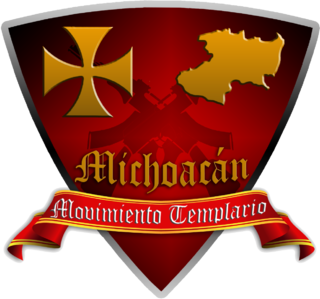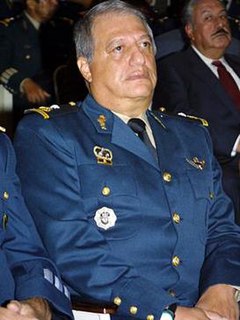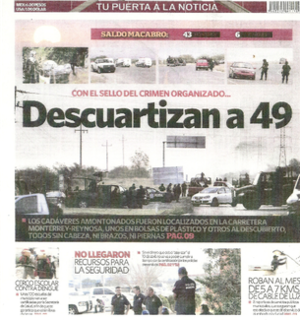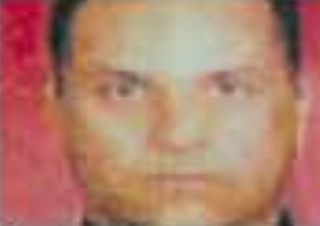Related Research Articles

Guerrero, officially the Free and Sovereign State of Guerrero, is one of the 32 states that comprise the 32 Federal Entities of Mexico. It is divided in 81 municipalities and its capital city is Chilpancingo and its largest city is Acapulco. It is located in Southwestern Mexico. It is bordered by the states of Michoacán to the north and west, the State of Mexico and Morelos to the north, Puebla to the northeast and Oaxaca to the east. In addition to the capital city, the state's largest cities include Acapulco, Petatlán, Ciudad Altamirano, Taxco, Iguala, Ixtapa, Zihuatanejo, and Santo Domingo. Today, it is home to a number of indigenous communities, including the Nahuas, Mixtecs, Tlapanecs, Amuzgos, and formerly Cuitlatecs. It is also home to communities of Afro-Mexicans in the Costa Chica region.
The timeline of some of the most relevant events in the Mexican drug war is set out below. Although violence between drug cartels had been occurring for three decades, the Mexican government held a generally passive stance regarding cartel violence through the 1980s and early 2000s.
The 2010 San Fernando massacre, also known as the first massacre of San Fernando, was the mass murder of 72 undocumented immigrants by Los Zetas drug cartel in the village of El Huizachal in the municipality of San Fernando, Tamaulipas, Mexico. The 72 killed—58 men and 14 women—were mainly from Central and South America, and they were shot in the back of the head and then piled up together. The bodies were found inside a ranch on 24 August 2010 by the Mexican military after they engaged in an armed confrontation with members of a drug cartel. They received information of the place after an Ecuadorian survived a shot to the neck and face, faked his death, and then made his way out of the ranch and up to a military checkout to ask for help. There were only three survivors. Investigators later mentioned that the massacre was a result of the immigrants' refusal to work for Los Zetas, or to provide money for their release.
This is a list of events that happened in 2010 in Mexico. The article also lists the most important political leaders during the year at both federal and state levels.
Gente Nueva, also known as Los Chapos, in reference to their drug lord Joaquín Guzmán Loera, is a large group of well-trained and experienced gunmen that function as one of the elite armed wings of the Sinaloa Cartel, created to counter, battle and destroy the Juárez Cartel's influence in the Mexican north-west, as well as to battle and destroy La Línea which is currently the Juárez Cartel's largest remaining cell.
This is a list of events that happened in 2011 in Mexico. The article also lists the most important political leaders during the year at both federal and state levels.
The 2011 San Fernando massacre, also known as the second massacre of San Fernando, was the mass murder of 193 people by Los Zetas drug cartel at La Joya ranch in the municipality of San Fernando, Tamaulipas, Mexico in March 2011. Authorities investigating the massacre reported numerous hijackings of passenger buses on Mexican Federal Highway 101 in San Fernando, and the kidnapped victims were later killed and buried in 47 clandestine mass graves. The investigations began immediately after several suitcases and other baggage went unclaimed in Reynosa and Matamoros, Tamaulipas. On 6 April 2011, Mexican authorities exhumed 59 corpses from eight mass graves. By 7 June 2011, after a series of multiple excavations, a total of 193 bodies were exhumed from mass graves in San Fernando.

The Knights Templar Cartel was a Mexican criminal organization originally composed of the remnants of La Familia Michoacana drug cartel based in the Mexican State of Michoacán.
The 2011 Durango massacres were a series of mass murders that occurred in 2011. According to El Universal and Yahoo! News, at least 340 bodies have been found in mass graves around the city of Durango as of February 2012; These mass graves are the first of their kind in the state of Durango and third of their kind in Mexico. These mass graves had more bodies than the 2011 Tamaulipas massacre of 189 bus passengers. Since April 2011, there have been 7 mass graves found around Durango. One of these mass graves was found in a vacant auto repair lot in Durango with 89 bodies. One of the bodies identified was Alfonso Peña, the former mayor of Tepehuanes Municipality, Durango.

The Apodaca prison riot occurred on 19 February 2012 at a prison in Apodaca, Nuevo León, Mexico. Mexico City officials stated that at least 44 people were killed, with another twelve injured. The Blog del Narco, a blog that documents events and people of the Mexican Drug War anonymously, reported that the actual (unofficial) death toll may be more than 70 people. The fight was between Los Zetas and the Gulf Cartel, two drug cartels that operate in northeastern Mexico. The governor of Nuevo León, Rodrigo Medina, mentioned on 20 February 2012 that 30 inmates escaped from the prison during the riot. Four days later, however, the new figures of the fugitives went down to 29. On 16 March 2012, the Attorney General's Office of Nuevo León confirmed that 37 prisoners had actually escaped on the day of the massacre. One of the fugitives, Óscar Manuel Bernal alias La Araña, is considered by the Mexican authorities to be "extremely dangerous," and is believed to be the leader of Los Zetas in the municipality of Monterrey. Some other fugitives were also leaders in the organization.
The Altamira prison brawl was a deadly fight that occurred on 4 January 2012 in Altamira, Tamaulipas, Mexico. Officials from the state of Tamaulipas confirmed that 31 people were killed, with another thirteen injured. The fight started after a drug gang burst into a section of the prison where they were banned from, attacking their rival gang housed there, triggering the fight. During the altercation, the inmates used several kinds of cold weapons (non-firearms) to kill their opponents. The prisoners also used sticks and knives to massacre the members of the rival gang.
The Coahuila mass graves was the mass murder of 38 people near the city of Piedras Negras, Coahuila, Mexico on 3 June 2011. The three clandestine mass graves where the bodies were exhumed were found by the Mexican military and authorized personnel after an anonymous call notified them of the location where the decaying bodies were. The investigators found buttons, shirts, coins, and watches. The mass graves were purposely covered with soil and grass to simulate a pasture. All of the bodies were burned to death.
The Nuevo León mass graves was the mass murder of over 70 people in the Nuevo León, Mexico on 25 June 2010 in several mass graves. The municipality of Juárez, Nuevo León counts with 51 of the 70 bodies found; most of the bodies were shot dead, while others were burned and mutilated.

The Jalisco New Generation Cartel or CJNG, formerly known as Los Mata Zetas, is a semi-militarized Mexican criminal group based in Jalisco which is headed by Nemesio Oseguera Cervantes, one of the world's most-wanted drug lords. The cartel has been characterized by its aggressive use of extreme violence and its public relations campaigns. Although the CJNG is particularly known for diversifying into various types of criminal rackets, drug trafficking as well as stealing crude oil remain among their most profitable criminal activities. The cartel has also been noted for cannibalizing some of its victims, sometimes during the training of new sicarios or cartel members as well as using drones to attack their enemies. U.S. prosecutors have said operatives of the cartel tried to buy belt-fed M-60 machine guns in the United States, and once brought down a Mexican military helicopter with a rocket-propelled grenade.

Mario Arturo Acosta Chaparro Escápite was a Mexican Army general who was shot dead in an incident in Mexico City. He had been incarcerated in the year 2000 for allegedly having ties with the Mexican criminal group known as the Juárez Cartel; he was later released in 2007 for lack of evidences against him. Acosta was also accused of 143–500 disappearances during Mexico's "Dirty War" in the 1970s.

The Cadereyta Jiménez massacre occurred on the Fed 40 on 12–13 May 2012. Mexican officials stated that 49 people were decapitated and mutilated by members of Los Zetas drug cartel and dumped by a roadside near the city of Monterrey in northern Mexico. The Blog del Narco, a blog that documents events and people of the Mexican Drug War anonymously, reported that the actual (unofficial) death toll may be more than 68 people. The bodies were found in the town of San Juan in the municipality of Cadereyta Jiménez, Nuevo León at about 4 a.m. on a non-toll highway leading to Reynosa, Tamaulipas. The forty-three men and six women killed had their heads, feet, and hands cut off, making their identification difficult. Those killed also bore signs of torture and were stuffed in plastic bags. The arrested suspects have indicated that the victims were Gulf Cartel members, but the Mexican authorities have not ruled out the possibility that they were U.S.-bound migrants. Four days before this incident, 18 people were found decapitated and dismembered near Mexico's second largest city, Guadalajara.
In 2011 and 2012, during the Mexican drug war, hundreds of people were killed in massacres by rival drug cartels who were fighting for power and territory. These organized-crime syndicates were grappling for control over the drug corridors to the United States, the drug markets in local cities, extortion rackets, and human smuggling. Massacres occurred in the states of Veracruz, Sinaloa, Jalisco, Tamaulipas and Nuevo León.

Óscar Eduardo Guerrero Silva, commonly referred to by his alias Z-8 and/or The Winnie Pooh, was a Mexican drug lord and high-ranking leader of Los Zetas, a Mexican criminal organization.

On September 26, 2014, forty-three male students disappeared from the Ayotzinapa Rural Teachers' College after being forcibly abducted in Iguala, Guerrero, Mexico. They were allegedly taken into custody by local police officers from Iguala and Cocula in collusion with organized crime. The mass kidnapping has caused continued international protests and social unrest, leading to the resignation of Guerrero Governor Ángel Aguirre Rivero in the face of statewide protests on October 23, 2014.
References
- ↑ (in Spanish) "Autoridades de Guerrero rescatan más cuerpos de la fosa de Taxco". CNNMexico. 7 June 2010. Retrieved 23 February 2012.
- ↑ (in Spanish) "Autoridades rescatan 53 cadáveres completos de fosa clandestina en Taxco". CNNMexico. 7 June 2010. Retrieved 23 February 2012.